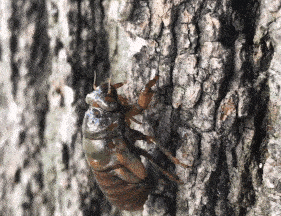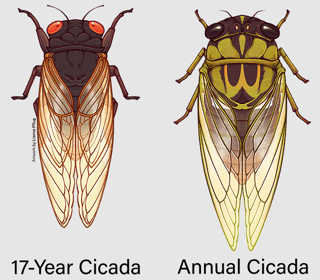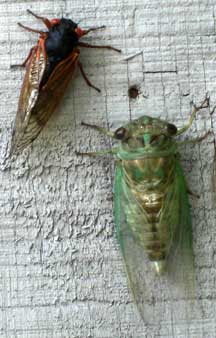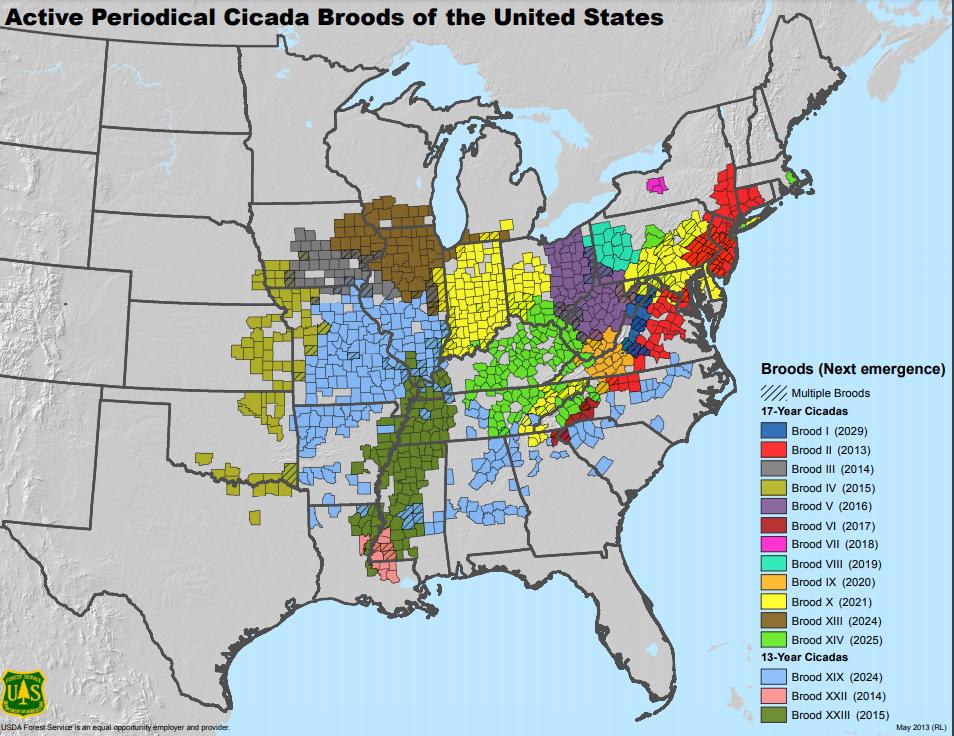I Wantedwanted to add a more thorough answer to this post (with some pictures) since they are bound to get a lot of press (and questions) this summer (2021) -- more on that later....
Life cycle of periodic cicada; Credit: Roy Troutman and Elias Bonaros, cicadamania
Nymph crawling up tree; Source: Peggy Notebart Nature Museum
Annual vs 13- and 17-Year Cicadas:
In North America, there is a need to distinguish between "annual" and "periodic" species of cicadas. Annual cicada species can be found essentially every single summer (although their life cycle is 2-5 years, there are enough overlapping broods that one can see them annually).
Periodic cicadas (genus Magicada), on the other hand, spend most of their lives living underground and synchronously arise only every 13 or 17 years depending on species and brood (13-year species more common in SE US and 17-year species more common in NE and midwestern US). They survive by sucking on xylem from deciduous tree roots.2. These periodic cicadas are unique to the Eastern US, and such long life cycles aren't found in insects anywhere else in the world.
These two subgroups of cicadas are easy to tell apart as a number of species of annual cicadas tend to be larger and green-hued whereas the periodic species are smaller, black-bodied, and have very conspicuous red eyes and tinted wings. Even the few darker annual species (e.g., Diceroprocta apache and various Okanagana species) lack the bright red eyes and red/orange-tinted wings seen in the periodic species.
Image sources: (L): Purdue Extension; (R): Carol Toman on whatsthatbug.com
The swarm is coming back!!
Periodic cicadas have the longest life-cycles of any insect, and their almost magical synchronous emergence every 13 or 17 years always captures the attention of many media sources and social circles/media. However, some of you may wonder: "wait, has it really been 17 years since we last saw these insects?..."
Well, the answer could be yes if you live in the right place, haven't moved, and haven't turned on your TV/computer lately. However, in certain areas, it's possible to see these insects more frequently! You see, there are actually multiple broods of these insects -- essentially separate populations -- that arise at different times.
The brood that is making all the media hype for emerging in 2021 is Brood X:
[The various specisspecies of North American cicadas] form mixed-species cohorts called broods whose members arise like clockwork on the same schedule. The broods are identified by Roman numerals. Brood X is the largest of the 12 broods of 17-year cicadas, which emerge in different years. Scientific American
Brood map for periodic cicadas. Source: Liebhold et al (2013)3 US Forest Service
As you can see, Brood X can be found in 10-11 states ranging from New Jersey to Illinois.
You can read more about periodic cicada broods on Wikipedia, and you can see range maps of both 13- and 17-year species here (from here).
Citations:
I Wanted to add a more thorough answer to this post (with some pictures) since they are bound to get a lot of press (and questions) this summer (2021) -- more on that later....
Life cycle of periodic cicada; Credit: Roy Troutman and Elias Bonaros, cicadamania
Nymph crawling up tree; Source: Peggy Notebart Nature Museum
Annual vs 13- and 17-Year Cicadas:
In North America, there is a need to distinguish between "annual" and "periodic" species of cicadas. Annual cicada species can be found essentially every single summer (although their life cycle is 2-5 years, there are enough overlapping broods that one can see them annually).
Periodic cicadas (genus Magicada), on the other hand, spend most of their lives living underground and synchronously arise only every 13 or 17 years depending on species and brood (13-year species more common in SE US and 17-year species more common in NE and midwestern US). They survive by sucking on xylem from deciduous tree roots.2. These periodic cicadas are unique to the Eastern US, and such long life cycles aren't found in insects anywhere else in the world.
These two subgroups of cicadas are easy to tell apart as a number of species of annual cicadas tend to be larger and green-hued whereas the periodic species are smaller, black-bodied, and have very conspicuous red eyes and tinted wings. Even the few darker annual species (e.g., Diceroprocta apache and various Okanagana species) lack the bright red eyes and red/orange-tinted wings seen in the periodic species.
Image sources: (L): Purdue Extension; (R): Carol Toman on whatsthatbug.com
The swarm is coming back!!
Periodic cicadas have the longest life-cycles of any insect, and their almost magical synchronous emergence every 13 or 17 years always captures the attention of many media sources and social circles/media. However, some of you may wonder: "wait, has it really been 17 years since we last saw these insects?..."
Well, the answer could be yes if you live in the right place, haven't moved, and haven't turned on your TV/computer lately. However, in certain areas, it's possible to see these insects more frequently! You see, there are actually multiple broods of these insects -- essentially separate populations -- that arise at different times.
The brood that is making all the media hype for emerging in 2021 is Brood X:
[The various specis of North American cicadas] form mixed-species cohorts called broods whose members arise like clockwork on the same schedule. The broods are identified by Roman numerals. Brood X is the largest of the 12 broods of 17-year cicadas, which emerge in different years. Scientific American
Brood map for periodic cicadas. Source: Liebhold et al (2013)3 US Forest Service
As you can see, Brood X can be found in 10-11 states ranging from New Jersey to Illinois.
You can read more about periodic cicada broods on Wikipedia, and you can see range maps of both 13- and 17-year species here (from here).
Citations:
I wanted to add a more thorough answer to this post (with some pictures) since they are bound to get a lot of press (and questions) this summer (2021) -- more on that later....
Life cycle of periodic cicada; Credit: Roy Troutman and Elias Bonaros, cicadamania
Nymph crawling up tree; Source: Peggy Notebart Nature Museum
Annual vs 13- and 17-Year Cicadas:
In North America, there is a need to distinguish between "annual" and "periodic" species of cicadas. Annual cicada species can be found essentially every single summer (although their life cycle is 2-5 years, there are enough overlapping broods that one can see them annually).
Periodic cicadas (genus Magicada), on the other hand, spend most of their lives living underground and synchronously arise only every 13 or 17 years depending on species and brood (13-year species more common in SE US and 17-year species more common in NE and midwestern US). They survive by sucking on xylem from deciduous tree roots.2. These periodic cicadas are unique to the Eastern US, and such long life cycles aren't found in insects anywhere else in the world.
These two subgroups of cicadas are easy to tell apart as a number of species of annual cicadas tend to be larger and green-hued whereas the periodic species are smaller, black-bodied, and have very conspicuous red eyes and tinted wings. Even the few darker annual species (e.g., Diceroprocta apache and various Okanagana species) lack the bright red eyes and red/orange-tinted wings seen in the periodic species.
Image sources: (L): Purdue Extension; (R): Carol Toman on whatsthatbug.com
The swarm is coming back!!
Periodic cicadas have the longest life-cycles of any insect, and their almost magical synchronous emergence every 13 or 17 years always captures the attention of many media sources and social circles/media. However, some of you may wonder: "wait, has it really been 17 years since we last saw these insects?..."
Well, the answer could be yes if you live in the right place, haven't moved, and haven't turned on your TV/computer lately. However, in certain areas, it's possible to see these insects more frequently! You see, there are actually multiple broods of these insects -- essentially separate populations -- that arise at different times.
The brood that is making all the media hype for emerging in 2021 is Brood X:
[The various species of North American cicadas] form mixed-species cohorts called broods whose members arise like clockwork on the same schedule. The broods are identified by Roman numerals. Brood X is the largest of the 12 broods of 17-year cicadas, which emerge in different years. Scientific American
Brood map for periodic cicadas. Source: Liebhold et al (2013)3 US Forest Service
As you can see, Brood X can be found in 10-11 states ranging from New Jersey to Illinois.
You can read more about periodic cicada broods on Wikipedia, and you can see range maps of both 13- and 17-year species here (from here).
Citations:
Life cycle of periodic cicada; Credit: Roy Troutman and Elias Bonaros, cicadamania
Nymph crawling up tree; Source: Peggy Notebart Nature Museum
Annual vs 13- and 17-Year Cicadas:
In North America, there is a need to distinguish between "annual" and "periodic" species of cicadas. Annual cicada species can be found essentially every single summer (although their life cycle is 2-5 years, there are enough overlapping broods that one can see them annually).
Periodic cicadas (genus Magicada), on the other hand, spend most of their lives living underground and synchronously arise only every 13 or 17 years depending on species and brood (13-year species more common in SE US and 17-year species more common in NE and midwestern US). They survive by sucking on xylem from deciduous tree roots.2. These periodic cicadas are unique to the Eastern US, and such long life cycles aren't found in insects anywhere else in the world.
These two subgroups of cicadas are easy to tell apart as a number of species of annual cicadas tend to be larger and green-hued whereas the periodic species are smaller, black-bodied, and have very conspicuous red eyes and tinted wings. Even the few darker annual species (e.g., Diceroprocta apache and various Okanagana species) lack the bright red eyes and red/orange-tinted wings seen in the periodic species.
Image sources: (L): Purdue Extension; (R): Carol Toman on whatsthatbug.com
The swarm is coming back!!
Periodic cicadas have the longest life-cycles of any insect, and their almost magical synchronous emergence every 13 or 17 years always captures the attention of many media sources and social circles/media. However, some of you may wonder: "wait, has it really been 17 years since we last saw these insects?..."
Well, the answer could be yes if you live in the right place, haven't moved, and haven't turned on your TV/computer lately. However, in certain areas, it's possible to see these insects more frequently! You see, there are actually multiple broods of these insects -- essentially separate populations -- that arise at different times.
The brood that is making all the media hype for emerging in 2021 is Brood X:
[The various specis of North American cicadas] form mixed-species cohorts called broods whose members arise like clockwork on the same schedule. The broods are identified by Roman numerals. Brood X is the largest of the 12 broods of 17-year cicadas, which emerge in different years. Scientific American
Brood map for periodic cicadas. Source: Liebhold et al (2013)3 US Forest Service
As you can see, Brood X can be found in 10-11 states ranging from New Jersey to Illinois.
You can read more about periodic cicada broods on Wikipedia, and you can see range maps of both 13- and 17-year species here (from here).
Citations:
3. Lloyd, M. and Dybas, H.S., 1966. The periodical cicada problem. I. Population ecology. Evolution, 20(2), pp.133-149.Liebhold, A. M., Bohne, M. J., and R. L. Lilja. 2013. Active Periodical Cicada Broods of the United States. USDA Forest Service Northern Research Station, Northeastern Area State and Private Forestry.
Life cycle of periodic cicada; Credit: Roy Troutman and Elias Bonaros, cicadamania
Nymph crawling up tree; Source: Peggy Notebart Nature Museum
Annual vs 13- and 17-Year Cicadas:
In North America, there is a need to distinguish between "annual" and "periodic" species of cicadas. Annual cicada species can be found essentially every single summer (although their life cycle is 2-5 years, there are enough overlapping broods that one can see them annually).
Periodic cicadas (genus Magicada), on the other hand, spend most of their lives living underground and synchronously arise only every 13 or 17 years depending on species and brood (13-year species more common in SE US and 17-year species more common in NE and midwestern US). They survive by sucking on xylem from deciduous tree roots.2. These periodic cicadas are unique to the Eastern US, and such long life cycles aren't found in insects anywhere else in the world.
These two subgroups of cicadas are easy to tell apart as a number of species of annual cicadas tend to be larger and green-hued whereas the periodic species are smaller, black-bodied, and have very conspicuous red eyes and tinted wings. Even the few darker annual species (e.g., Diceroprocta apache and various Okanagana species) lack the bright red eyes and red/orange-tinted wings seen in the periodic species.
Image sources: (L): Purdue Extension; (R): Carol Toman on whatsthatbug.com
The swarm is coming back!!
Periodic cicadas have the longest life-cycles of any insect, and their almost magical synchronous emergence every 13 or 17 years always captures the attention of many media sources and social circles/media. However, some of you may wonder: "wait, has it really been 17 years since we last saw these insects?..."
Well, the answer could be yes if you live in the right place, haven't moved, and haven't turned on your TV/computer lately. However, in certain areas, it's possible to see these insects more frequently! You see, there are actually multiple broods of these insects -- essentially separate populations -- that arise at different times.
The brood that is making all the media hype for emerging in 2021 is Brood X:
[The various specis of North American cicadas] form mixed-species cohorts called broods whose members arise like clockwork on the same schedule. The broods are identified by Roman numerals. Brood X is the largest of the 12 broods of 17-year cicadas, which emerge in different years. Scientific American
Brood map for periodic cicadas. Source: Liebhold et al (2013)3 US Forest Service
As you can see, Brood X can be found in 10-11 states ranging from New Jersey to Illinois.
You can read more about periodic cicada broods on Wikipedia, and you can see range maps of both 13- and 17-year species here (from here).
Citations:
Life cycle of periodic cicada; Credit: Roy Troutman and Elias Bonaros, cicadamania
Nymph crawling up tree; Source: Peggy Notebart Nature Museum
Annual vs 13- and 17-Year Cicadas:
In North America, there is a need to distinguish between "annual" and "periodic" species of cicadas. Annual cicada species can be found essentially every single summer (although their life cycle is 2-5 years, there are enough overlapping broods that one can see them annually).
Periodic cicadas (genus Magicada), on the other hand, spend most of their lives living underground and synchronously arise only every 13 or 17 years depending on species and brood (13-year species more common in SE US and 17-year species more common in NE and midwestern US). They survive by sucking on xylem from deciduous tree roots.2. These periodic cicadas are unique to the Eastern US, and such long life cycles aren't found in insects anywhere else in the world.
These two subgroups of cicadas are easy to tell apart as a number of species of annual cicadas tend to be larger and green-hued whereas the periodic species are smaller, black-bodied, and have very conspicuous red eyes and tinted wings. Even the few darker annual species (e.g., Diceroprocta apache and various Okanagana species) lack the bright red eyes and red/orange-tinted wings seen in the periodic species.
Image sources: (L): Purdue Extension; (R): Carol Toman on whatsthatbug.com
The swarm is coming back!!
Periodic cicadas have the longest life-cycles of any insect, and their almost magical synchronous emergence every 13 or 17 years always captures the attention of many media sources and social circles/media. However, some of you may wonder: "wait, has it really been 17 years since we last saw these insects?..."
Well, the answer could be yes if you live in the right place, haven't moved, and haven't turned on your TV/computer lately. However, in certain areas, it's possible to see these insects more frequently! You see, there are actually multiple broods of these insects -- essentially separate populations -- that arise at different times.
The brood that is making all the media hype for emerging in 2021 is Brood X:
[The various specis of North American cicadas] form mixed-species cohorts called broods whose members arise like clockwork on the same schedule. The broods are identified by Roman numerals. Brood X is the largest of the 12 broods of 17-year cicadas, which emerge in different years. Scientific American
Brood map for periodic cicadas. Source: Liebhold et al (2013)3 US Forest Service
As you can see, Brood X can be found in 10-11 states ranging from New Jersey to Illinois.
You can read more about periodic cicada broods on Wikipedia, and you can see range maps of both 13- and 17-year species here (from here).
Citations:




